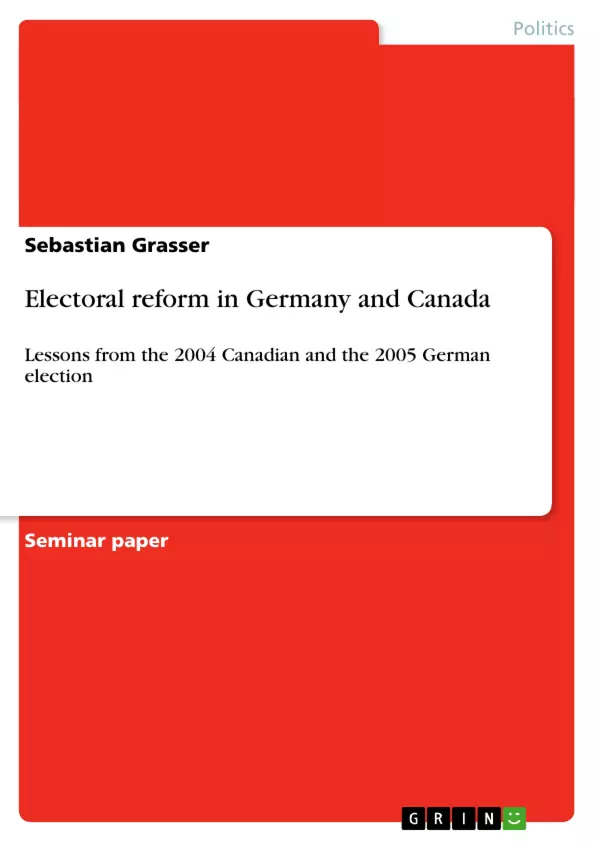The voter turnout of 60.9% in the 2004 Canadian general election has been the lowest ever in Canadian electoral history. The election resulted in a minority government for Paul Martin’s Liberals that lost votes after an infamous sponsorship scandal. This scandal undermined Liberal credibility as “sums of money were paid illicitly, supposedly to promote national feeling in Quebec.” The Liberals could only win 135 seats with 36.7% of the popular vote, and more than half of their seats (75) came from Ontario. Canada’s regional cleavages, i.e. its highly regionalized nature, are the origin of such a development. The electoral system, the single-member plurality, deteriorates this situation as it favors parties with a regional basis and leaves out parties with a small nationwide electorate.
In contrast to Canada, German voters are familiar with elections where neither party can win the majority of seats in the German parliament, the Bundestag. The German electoral system favors coalitions, which is unknown to Canadian voters.
This paper examines both the electoral system of Canada and Germany and shows overlapping in both system with the usage of two former elections as case study.
Inhaltsverzeichnis (Table of Contents)
- The 2005 German and 2004 Canadian election
- Outcomes and characteristics
- Lessons from both elections
- Electoral systems: Canada and Germany
- An overview of electoral systems
- The German electoral system
- Functionality and characteristics of the German system
- Problems that arise from Germany's mixed-member-proportional system
- Canada's single-member majority system
- Functionality and characteristics of Canada's “first-past-the-post"-system
- The problems of Canada's single-member plurality
- The German model applied to Canada: how would Canada vote with a mixed-member-proportional system?
- Should Canada adopt the German electoral system?
Zielsetzung und Themenschwerpunkte (Objectives and Key Themes)
This term paper examines the lessons learned from the 2004 Canadian and the 2005 German elections with a focus on the impact of electoral systems on political outcomes. By comparing and contrasting the Canadian single-member plurality system with the German mixed-member proportional system, the paper aims to shed light on the advantages and disadvantages of each system. It investigates how these systems influence party strategies, voter behavior, and ultimately, the formation of governments.
- The impact of electoral systems on political outcomes
- Comparison of Canadian and German electoral systems
- Analysis of regionalization and its influence on elections
- Exploration of coalition formation and its implications
- The potential application of the German model to Canada
Zusammenfassung der Kapitel (Chapter Summaries)
Chapter 1 provides an overview of the 2004 Canadian and the 2005 German elections, highlighting key outcomes and characteristics. The chapter analyzes voter turnout, party performance, and the emergence of regional divisions in both countries. It also sheds light on the impact of scandals and political events on electoral outcomes.
Chapter 2 delves into the electoral systems of Canada and Germany. It begins with a general overview of electoral systems, followed by a detailed examination of the German mixed-member proportional system and its functionality. The chapter then explores the Canadian single-member plurality system, outlining its advantages and disadvantages. The analysis also considers the challenges associated with regional fragmentation in both countries.
Schlüsselwörter (Keywords)
This paper focuses on electoral reform, comparing the Canadian single-member plurality system with the German mixed-member proportional system. It examines the impact of these systems on regionalization, coalition formation, and the overall political landscape. Key terms and concepts include electoral systems, political culture, regional cleavages, minority governments, coalition governments, voter turnout, and party strategies. The analysis draws upon insights from the 2004 Canadian and 2005 German elections, demonstrating the real-world implications of different electoral systems.
- Citar trabajo
- Sebastian Grasser (Autor), 2006, Electoral reform in Germany and Canada, Múnich, GRIN Verlag, https://www.grin.com/document/76784



